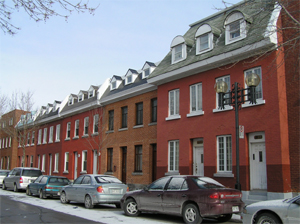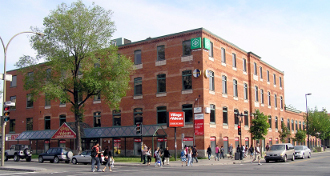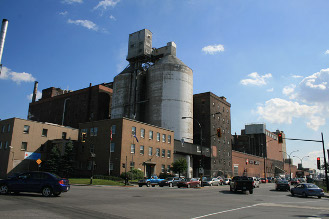

Montreal DistrictsHochelaga-MaisonneuveThere's a lot to say about Hochelaga-Maisonneuve, now a district, but once a city. Poverty, dirty lanes, violence and shabby buildings, that’s how the sector is usually described, but there’s a lot more to it, quite a lot in fact. Hochelaga, land of the Iroquois of the Saint-Laurent is what the Island of Montreal has been called for centuries. Hochelaga is also the subject of more than one hundred paintings created by Marc-Aurèle Fortin. In constrast, the Cité de Maisonneuve is where its then 287 inhabitants owned vast lands between what is now Bourbonnière, Vimont, the Saint-Laurent River and Rosemont, and where its political leaders wanted to build a "French Westmount". The architectural heritage from the period is indeed remarkable. It’s a Village!The district has begun to change, but prejudices are still very strong. People don’t come and visit Hochelaga-Maisonneuve, they don’t dare. When they learn that cool things are happening, they are surprised. Since 1996, the young population has significantly increased, but when residents invite their friends, they don't tell them they live in Hochelaga-Maisonneuve, instead they call it HO-MA, as if they were ashamed. The name HO-MA appeared two or three years ago. The idea behind the diminutive is to define the sector with a more tempting term. Part of the difficulties the district experiences is due to the negative perceptions people have. Jobs in my AreaThere are three industrial parks in Hochelaga-Maisonneuve with a hundred companies or so established on their grounds. The Port of Montreal occupies a privileged position because of its localization and because of its outstanding role. The Port is one of the most frequented harbor in the world and one of the most important in container traffic. One third of the local employment in the district is in consumer services, especially in retail. The rest is in production, transportation and wholesale. The professional, scientific and technical services are rapidly growing. Importance of Leisure ActivitiesBecause of the Parc Olympique, the Jardin Botanique, the Insectarium and the Biodôme, Hochelaga-Maisonneuve is considered an important recreational territory. The Planetarium is also part of the Muséum nature Montréal, but is located in the Old-Montreal district in the Ville-Marie borough. Even if the Parc Maisonneuve has the renowned Botanical Garden, the Biodôme, the Insectarium and the Olympic Stadium as neighbors, it enjoys a great deal of popularity of its own as one of the most beautiful and largest urban park in Montreal. The Centre Pierre Charbonneau and the Arena Maurice Richard as well as the Sports Centre of the Olympic Park offer excellent facilities for athletic sports. Any of these installations can also be used for major public events. Arts and ShowsThe district offers the Théâtre Denise Pelletier, the Musée du Château Dufresne, two Maisons de la culture, Maisonneuve and Mercier, and four libraries, Hochelaga, Maisonneuve, Langelier and Mercier. History of Montreal
Before 1883, Hochelaga and Maisonneuve formed one big city. The Cité de Maisonneuve would celebrate its more than 125th anniversary if it still was a City. In 1910, the sector was the 5th most important industrial sector in Canada and the capital of the shoe manufacturing. At one time 30 shoe factories were established on the territory. The opening of all those factories during the 20th century brought thousands of workers who, unfortunately, ahd to live in poor conditions. In those days, workers earned 17 cents an hour and butter cost 24 cents a pound. They worked 12 hours a day, 6 days a week. Many of the typical “maisons en rangées” they lived in still exist on Létourneux and LaSalle. Between 1450 and 1526 on Dézéry there are very good examples of what was probably the Maisons Hudon built by Victor Hudon for its employees. These dwellings have been built before 1890, probably in 1881 or 1885. Like the Maisons Hudon on St-Germain, they could have been built to give a roof over the head of the Hudon workers during a housing crisis. As for the rich industrials, they built themselves sumptuous houses. Many can still be admired on Adam and Lafontaine. Their large wooden balconies decorated with pediments are easy to recognize. The two banks built side by side on Ontario and the superb Église Très-Saint-Nom-de-Jésus on Adam are additional indications of ancient prosperity in Hochelaga-Maisonneuve. Modern Home Architecture
The Watson, Foster & Co. dates back to 1896 and is located corner of Pie IX and Ontario. Built in 1909 and now called "Place Ontario", the building is presently occupied by the Village des Valeurs. In 1907, the Corporation des Biscuits Viau settled on Ontario, corner of Viau. Today, a sign of modern times, the old factory has been transformed into condos. The McDermott Shoe Company built in 1909 and located corner of Létourneux and Rouen was a medium size factory that employed 125 employees in 1911. Today, part of the building is being transformed into studios. 
The Poliquin & Gagnon shoe factory corner of LaSalle and Rouen built in 1909 shows many interesting details like different colour bricks, brick designs and arched windows.
The windows of the United Shoe Machinery Company of Canada are bigger because of the frame of the building is made of iron. Built in 1911 on Boyce now Pierre de Coubertin, this American company manufactured the equipment used in shoe factories. The St-Lawrence Sugar is a large refinery established on Notre-Dame corner of Pie IX since 1887. The company built many rectangular buildings that are now surrounded by more recent ones. Nowadays, the refinery is called Lantic Sugar Thank you for visiting Hochelaga-Maisonneuve. Mercier Exit Hochelaga-Maisonneuve
|
Montreal Districts
What district am I in?
Ahuntsic
Anjou
Cartierville
Côte-des-Neiges
Hochelaga-Maisonneuve
Île Bizard
Lachine
LaSalle
Mercier
Montréal-Nord
Notre-Dame-de-Grâce
Outremont
Parc-Extension
Petite-Patrie
Pierrefonds
Plateau-Mont-Royal
Pointe-aux-Trembles
Rivière-des-Prairies
Rosemont
Roxboro
Sainte-Geneviève
Saint-Laurent
Saint-Léonard
Saint-Michel
Sud-Ouest
Verdun
Ville-Marie
Villeray
Atlas de l'emploi
Images Montréal
Images Montreal is a huge project that aims to be the biggest exclusive website of Montreal's skyscrapers, historical buildings and architecture landmarks.
Old historical monuments have a lot of interest as much as new apartment buildings, new skyscrapers or graffitis.
Montreal by Metro
Montreal by Metro is an unofficial website for fans of Montreal's metro system.
Our modern rapid transit system is one of the most architecturally distinctive subway systems in the world.
Unlike many other subway networks, every station in Montreal is distinct.
The system is beautifully decorated with hundreds of pieces of public art, including sculptures, frescoes, and stained glass.
STM Montréal
STM Montreal is composed of 68 metro stations spread along four lines and of a network made of 170 daytime and 20 night time bus service routes.
The metro provides 1.3 million trips every day. STM Montreal web site also offers a section called Art in the Métro.


























































